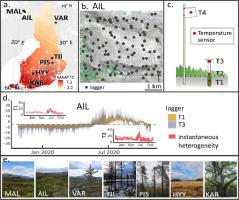Agricultural and Forest Meteorology ( IF 5.6 ) Pub Date : 2022-06-06 , DOI: 10.1016/j.agrformet.2022.109037 Juha Aalto , Vilna Tyystjärvi , Pekka Niittynen , Julia Kemppinen , Tuuli Rissanen , Hilppa Gregow , Miska Luoto

|
Microclimate varies greatly over short horizontal and vertical distances, and timescales. This multi-level heterogeneity influences terrestrial biodiversity and ecosystem functions by determining the ambient environment where organisms live in. Fine-scale heterogeneity in microclimate temperatures is driven by local topography, land and water cover, snow, and soil characteristics. However, their relative influence over boreal and tundra biomes and in different seasons, has not been comprehensively quantified. Here, we aim to (1) quantify temperature variations measured at three heights: soil (-6 cm), near-surface (15 cm) and air (150 cm), and (2) determine the relative influence of the environmental variables in driving thermal variability. We measured temperature at 446 sites within seven focus areas covering large macroclimatic, topographic, and ecosystem gradients (tundra, mires, forests) of northern Europe. Our data, consisting of over 60 million temperature readings during the study period of 2019/11–2020/10, reveal substantial thermal variability within and across the focus areas. Near-surface temperatures in the tundra showed the greatest instantaneous differences within a given focus area (32.3 °C) while the corresponding differences for soil temperatures ranged from 10.0 °C (middle boreal forest) to 27.1 °C (tundra). Instantaneous differences in wintertime air temperatures were the largest in the tundra (up to 25.6°C, median 4.2 °C), while in summer the differences were largest in the southern boreal forest (13.1°C, median 4.8°C). Statistical analyses indicate that monthly-aggregated temperature variations in boreal forests are closely linked to water bodies, wetlands, and canopy cover, whereas in the tundra, variation was linked to elevation, topographic solar radiation, and snow cover. The results provide new understanding on the magnitude of microclimate temperature variability and its seasonal drivers and will help to project local impacts of climate change on boreal forest and tundra ecosystems.
中文翻译:

从北方森林到苔原的小气候温度变化
小气候在短的水平和垂直距离以及时间尺度上变化很大。这种多层次的异质性通过确定生物所在的周围环境来影响陆地生物多样性和生态系统功能。微气候温度的精细异质性是由当地地形、土地和水覆盖、雪和土壤特征驱动的。然而,它们对北方和苔原生物群落以及不同季节的相对影响尚未得到全面量化。在这里,我们的目标是 (1) 量化在三个高度测量的温度变化:土壤 (-6 cm)、近地表 (15 cm) 和空气 (150 cm),以及 (2) 确定环境变量的相对影响驱动热变率。我们测量了 7 个重点区域内 446 个地点的温度,涵盖大的宏观气候、地形、和北欧的生态系统梯度(苔原、泥沼、森林)。我们的数据包含 2019/11 至 2020/10 研究期间的超过 6000 万个温度读数,揭示了重点区域内和重点区域之间的巨大热变率。苔原的近地表温度在给定的重点区域(32.3°C)内显示出最大的瞬时差异,而土壤温度的相应差异范围从 10.0°C(中部北方森林)到 27.1°C(苔原)。冬季气温的瞬时差异在苔原地区最大(高达 25.6°C,中值 4.2°C),而在夏季,南部北方森林的差异最大(13.1°C,中值 4.8°C)。统计分析表明,北方森林的月累计温度变化与水体、湿地、和树冠覆盖,而在苔原,变化与海拔、地形太阳辐射和积雪有关。结果提供了对小气候温度变化幅度及其季节性驱动因素的新认识,并将有助于预测气候变化对北方森林和苔原生态系统的当地影响。











































 京公网安备 11010802027423号
京公网安备 11010802027423号